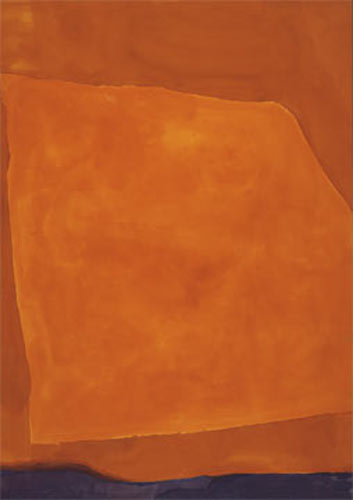
“Inside the museum infinity goes up on trial,” sang Bob Dylan in “Visions of Johanna,” suggesting that sometimes art achieves timelessness while more often it fades into oblivion. Pop musing aside, much of the work so tastefully presented here by seventeen abstractionists active during the 1960s seems destined to last. Called in turn Post-Painterly Abstraction, Minimalism, Hard Edge, Geometric Abstraction, and Systems, one can characterize this art in part by works of emotionally cool and formally seamless monochromatic color fields painted on geometrically shaped surfaces. Reductivist by intent or temperament, the examples here are expunged of pictorial depth and at times almost mechanically executed to emphasize the “thingness” of the work itself rather than the personality of the artist who made it.
Perhaps ad nauseum, critics have also discussed the artists gathered here as reacting against the preceding generation of Abstract Expressionists, whose heroic quest for personal meaning, psychological depth and enlightenment, was linked together with ground-breaking aesthetic experimentation that unashamedly revealed its methods of production. However a close look at the work in “Surface Truths: Abstract Painting in the Sixties” proves just how much these post-Abstract Expressionist artists admired their forebear’s protean energy and commitment to high art as a “religious” ideal. In addition, they regarded as courageous the struggle to break free from European Modernism’s previously hegemonic grasp on art.
For example, Helen Frankenthaler created her large burnt orange piece titled “Adriatic” by directly staining a raw canvas with poured and diluted acrylic paint. Yet while Frankenthaler’s practice immediately influenced her contemporaries, such as Morris Louis and Kenneth Nolan (both in this show as well), viewers can also easily perceive how Jackson Pollock’s vigorously splashed drips in his iconic work of the late 1940s morphed into Frankenthaler’s more smoothly applied smeared rivulets of free-flowing color in this painting. Clearly both artists shared the same improvisational instinct and timelessly lyrical muse, albeit in differing degrees of density and intensity.
Pollock, Willem de Kooning, Franz Kline, and other AE painters exemplified Friedrich Nietzsche’s archetypal “Dionysian” artist as one driven by will and instinct who, as a result, creates with intuitive abandon. These 60’s abstractionists stand as their Apollonian counterpart. They tended to work more out of calculated rationality and measured aesthetic decision making. Yet just as the poet Wallace Stevens wrote that a violent order is a disorder and a great disorder is an order. In this case the opposites attract and extreme points on a spectrum merge together as one. This may explain why, when looking at the perfectly proportioned overlapping arches of florescent paint bands in Stella’s gigantic “Damascus Gate 1,” a viewer may sense a ritualistic compulsion at work not far removed from Pollock’s spellbound act of dancing around and across his prone canvases in the action of painting them in his tiny East Hampton studio.
As Stella acknowledged, “Both Pollock and (Hans) Hoffman … established American painting as a real thing for me,” and that “I could find myself in relationship to Pollock and Hoffman rather than Picasso and Matisse.”
Just as Frankenthaler and Pollock recognized Abstract Expressionism as a starting point for their work, one might consider other paintings in this show, such as “Red,” by Thomas Downing (known as the “pioneer of the dot”) and Takeshi Kawashima’s “Abstraction” for the influence they would soon have on conceptual and/or structuralist-based artists such as John Baldessari. Both Downing’s and Kawashima’s paintings present well-ordered rows of red circular shapes. Downing’s Op Art-like spheres are surrounded by negative space that establishes an in-and-out breath-like rhythm for the eyes, until what visually protrudes and recedes becomes an indistinguishable blur. Kawashima’s awkwardly rounded objects are gathered into an encompassing grid that unifies the work. This painting also speaks in a kind of conceptual and systematic voice of inner and external space and of the goal of containing, if not taming the power of paint. On the other hand, the Abstract Expressionists, while almost ruled by the very act of art making itself, found ecstasy and meaning in allowing their paint to break boundaries and run free. That it sprinted directly into the kind of oppositely valued abstract painting represented in this exhibition should serve as proof enough (for the time being, at least) that its vitality has had the power to endure.
Published courtesy of ArtSceneCal ©2011
